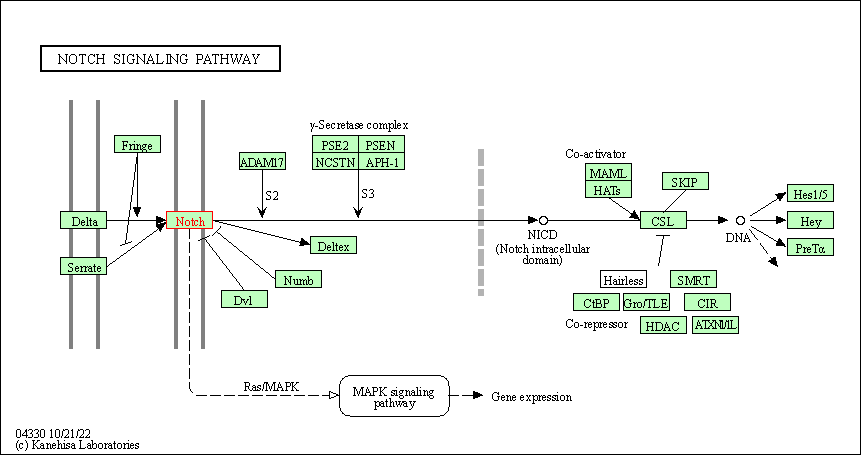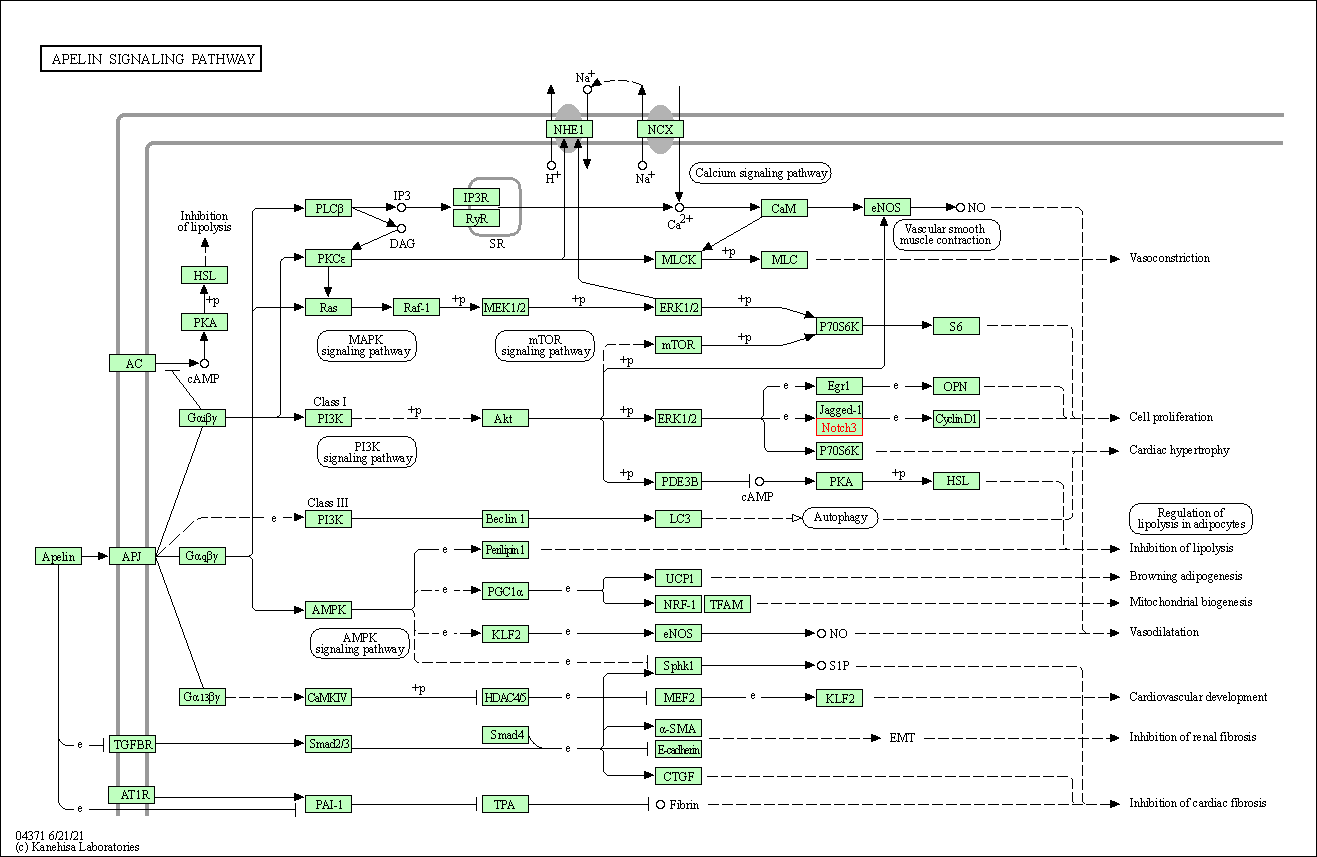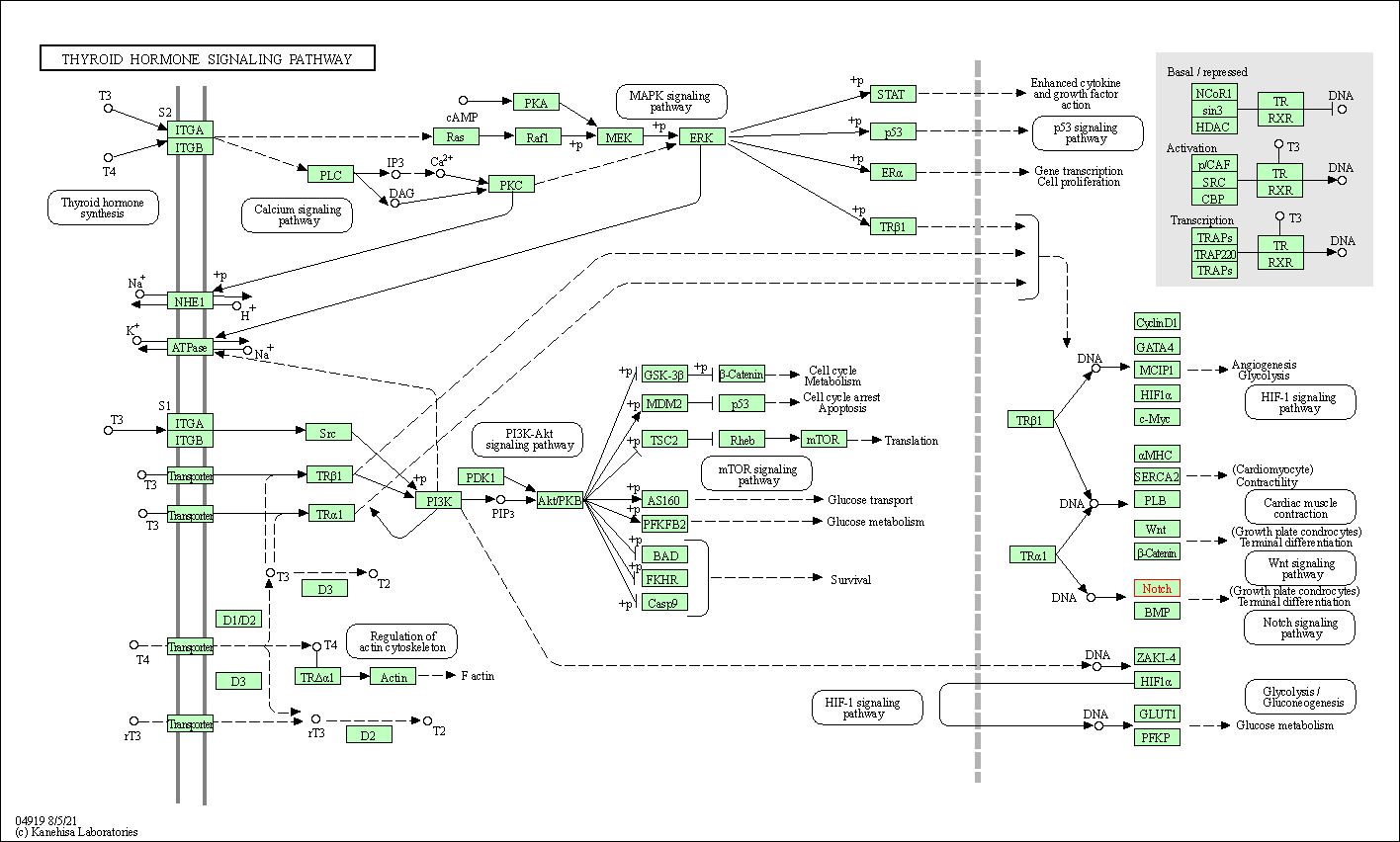Target Information
| Target General Information | Top | |||||
|---|---|---|---|---|---|---|
| Target ID |
T44684
(Former ID: TTDI02135)
|
|||||
| Target Name |
Notch-3 receptor (NOTCH3)
|
|||||
| Synonyms |
Notch 3 intracellular domain; Notch 3; Neurogenic locus notch homolog protein 3
Click to Show/Hide
|
|||||
| Gene Name |
NOTCH3
|
|||||
| Target Type |
Clinical trial target
|
[1] | ||||
| Disease | [+] 2 Target-related Diseases | + | ||||
| 1 | Lung cancer [ICD-11: 2C25] | |||||
| 2 | Pancreatic cancer [ICD-11: 2C10] | |||||
| Function |
Upon ligand activation through the released notch intracellular domain (NICD) it forms a transcriptional activator complex with RBPJ/RBPSUH and activates genes of the enhancer of split locus. Affects the implementation of differentiation, proliferation and apoptotic programs. Functions as a receptor for membrane-bound ligands Jagged1, Jagged2 and Delta1 to regulate cell-fate determination.
Click to Show/Hide
|
|||||
| BioChemical Class |
Notch protein
|
|||||
| UniProt ID | ||||||
| Sequence |
MGPGARGRRRRRRPMSPPPPPPPVRALPLLLLLAGPGAAAPPCLDGSPCANGGRCTQLPS
REAACLCPPGWVGERCQLEDPCHSGPCAGRGVCQSSVVAGTARFSCRCPRGFRGPDCSLP DPCLSSPCAHGARCSVGPDGRFLCSCPPGYQGRSCRSDVDECRVGEPCRHGGTCLNTPGS FRCQCPAGYTGPLCENPAVPCAPSPCRNGGTCRQSGDLTYDCACLPGFEGQNCEVNVDDC PGHRCLNGGTCVDGVNTYNCQCPPEWTGQFCTEDVDECQLQPNACHNGGTCFNTLGGHSC VCVNGWTGESCSQNIDDCATAVCFHGATCHDRVASFYCACPMGKTGLLCHLDDACVSNPC HEDAICDTNPVNGRAICTCPPGFTGGACDQDVDECSIGANPCEHLGRCVNTQGSFLCQCG RGYTGPRCETDVNECLSGPCRNQATCLDRIGQFTCICMAGFTGTYCEVDIDECQSSPCVN GGVCKDRVNGFSCTCPSGFSGSTCQLDVDECASTPCRNGAKCVDQPDGYECRCAEGFEGT LCDRNVDDCSPDPCHHGRCVDGIASFSCACAPGYTGTRCESQVDECRSQPCRHGGKCLDL VDKYLCRCPSGTTGVNCEVNIDDCASNPCTFGVCRDGINRYDCVCQPGFTGPLCNVEINE CASSPCGEGGSCVDGENGFRCLCPPGSLPPLCLPPSHPCAHEPCSHGICYDAPGGFRCVC EPGWSGPRCSQSLARDACESQPCRAGGTCSSDGMGFHCTCPPGVQGRQCELLSPCTPNPC EHGGRCESAPGQLPVCSCPQGWQGPRCQQDVDECAGPAPCGPHGICTNLAGSFSCTCHGG YTGPSCDQDINDCDPNPCLNGGSCQDGVGSFSCSCLPGFAGPRCARDVDECLSNPCGPGT CTDHVASFTCTCPPGYGGFHCEQDLPDCSPSSCFNGGTCVDGVNSFSCLCRPGYTGAHCQ HEADPCLSRPCLHGGVCSAAHPGFRCTCLESFTGPQCQTLVDWCSRQPCQNGGRCVQTGA YCLCPPGWSGRLCDIRSLPCREAAAQIGVRLEQLCQAGGQCVDEDSSHYCVCPEGRTGSH CEQEVDPCLAQPCQHGGTCRGYMGGYMCECLPGYNGDNCEDDVDECASQPCQHGGSCIDL VARYLCSCPPGTLGVLCEINEDDCGPGPPLDSGPRCLHNGTCVDLVGGFRCTCPPGYTGL RCEADINECRSGACHAAHTRDCLQDPGGGFRCLCHAGFSGPRCQTVLSPCESQPCQHGGQ CRPSPGPGGGLTFTCHCAQPFWGPRCERVARSCRELQCPVGVPCQQTPRGPRCACPPGLS GPSCRSFPGSPPGASNASCAAAPCLHGGSCRPAPLAPFFRCACAQGWTGPRCEAPAAAPE VSEEPRCPRAACQAKRGDQRCDRECNSPGCGWDGGDCSLSVGDPWRQCEALQCWRLFNNS RCDPACSSPACLYDNFDCHAGGRERTCNPVYEKYCADHFADGRCDQGCNTEECGWDGLDC ASEVPALLARGVLVLTVLLPPEELLRSSADFLQRLSAILRTSLRFRLDAHGQAMVFPYHR PSPGSEPRARRELAPEVIGSVVMLEIDNRLCLQSPENDHCFPDAQSAADYLGALSAVERL DFPYPLRDVRGEPLEPPEPSVPLLPLLVAGAVLLLVILVLGVMVARRKREHSTLWFPEGF SLHKDVASGHKGRREPVGQDALGMKNMAKGESLMGEVATDWMDTECPEAKRLKVEEPGMG AEEAVDCRQWTQHHLVAADIRVAPAMALTPPQGDADADGMDVNVRGPDGFTPLMLASFCG GALEPMPTEEDEADDTSASIISDLICQGAQLGARTDRTGETALHLAARYARADAAKRLLD AGADTNAQDHSGRTPLHTAVTADAQGVFQILIRNRSTDLDARMADGSTALILAARLAVEG MVEELIASHADVNAVDELGKSALHWAAAVNNVEATLALLKNGANKDMQDSKEETPLFLAA REGSYEAAKLLLDHFANREITDHLDRLPRDVAQERLHQDIVRLLDQPSGPRSPPGPHGLG PLLCPPGAFLPGLKAAQSGSKKSRRPPGKAGLGPQGPRGRGKKLTLACPGPLADSSVTLS PVDSLDSPRPFGGPPASPGGFPLEGPYAAATATAVSLAQLGGPGRAGLGRQPPGGCVLSL GLLNPVAVPLDWARLPPPAPPGPSFLLPLAPGPQLLNPGTPVSPQERPPPYLAVPGHGEE YPAAGAHSSPPKARFLRVPSEHPYLTPSPESPEHWASPSPPSLSDWSESTPSPATATGAM ATTTGALPAQPLPLSVPSSLAQAQTQLGPQPEVTPKRQVLA Click to Show/Hide
|
|||||
| 3D Structure | Click to Show 3D Structure of This Target | AlphaFold | ||||
| Drugs and Modes of Action | Top | |||||
|---|---|---|---|---|---|---|
| Clinical Trial Drug(s) | [+] 1 Clinical Trial Drugs | + | ||||
| 1 | Tarextumab | Drug Info | Phase 2 | Pancreatic cancer | [2], [3], [4], [5] | |
| Mode of Action | [+] 1 Modes of Action | + | ||||
| Modulator | [+] 1 Modulator drugs | + | ||||
| 1 | Tarextumab | Drug Info | [1] | |||
| Cell-based Target Expression Variations | Top | |||||
|---|---|---|---|---|---|---|
| Cell-based Target Expression Variations | ||||||
| Different Human System Profiles of Target | Top |
|---|---|
|
Human Similarity Proteins
of target is determined by comparing the sequence similarity of all human proteins with the target based on BLAST. The similarity proteins for a target are defined as the proteins with E-value < 0.005 and outside the protein families of the target.
A target that has fewer human similarity proteins outside its family is commonly regarded to possess a greater capacity to avoid undesired interactions and thus increase the possibility of finding successful drugs
(Brief Bioinform, 21: 649-662, 2020).
Human Tissue Distribution
of target is determined from a proteomics study that quantified more than 12,000 genes across 32 normal human tissues. Tissue Specificity (TS) score was used to define the enrichment of target across tissues.
The distribution of targets among different tissues or organs need to be taken into consideration when assessing the target druggability, as it is generally accepted that the wider the target distribution, the greater the concern over potential adverse effects
(Nat Rev Drug Discov, 20: 64-81, 2021).
Human Pathway Affiliation
of target is determined by the life-essential pathways provided on KEGG database. The target-affiliated pathways were defined based on the following two criteria (a) the pathways of the studied target should be life-essential for both healthy individuals and patients, and (b) the studied target should occupy an upstream position in the pathways and therefore had the ability to regulate biological function.
Targets involved in a fewer pathways have greater likelihood to be successfully developed, while those associated with more human pathways increase the chance of undesirable interferences with other human processes
(Pharmacol Rev, 58: 259-279, 2006).
Biological Network Descriptors
of target is determined based on a human protein-protein interactions (PPI) network consisting of 9,309 proteins and 52,713 PPIs, which were with a high confidence score of ≥ 0.95 collected from STRING database.
The network properties of targets based on protein-protein interactions (PPIs) have been widely adopted for the assessment of target’s druggability. Proteins with high node degree tend to have a high impact on network function through multiple interactions, while proteins with high betweenness centrality are regarded to be central for communication in interaction networks and regulate the flow of signaling information
(Front Pharmacol, 9, 1245, 2018;
Curr Opin Struct Biol. 44:134-142, 2017).
Human Similarity Proteins
Human Tissue Distribution
Human Pathway Affiliation
Biological Network Descriptors
|
|
|
Note:
If a protein has TS (tissue specficity) scores at least in one tissue >= 2.5, this protein is called tissue-enriched (including tissue-enriched-but-not-specific and tissue-specific). In the plots, the vertical lines are at thresholds 2.5 and 4.
|




| KEGG Pathway | Pathway ID | Affiliated Target | Pathway Map |
|---|---|---|---|
| Notch signaling pathway | hsa04330 | Affiliated Target |

|
| Class: Environmental Information Processing => Signal transduction | Pathway Hierarchy | ||
| Apelin signaling pathway | hsa04371 | Affiliated Target |

|
| Class: Environmental Information Processing => Signal transduction | Pathway Hierarchy | ||
| Th1 and Th2 cell differentiation | hsa04658 | Affiliated Target |

|
| Class: Organismal Systems => Immune system | Pathway Hierarchy | ||
| Thyroid hormone signaling pathway | hsa04919 | Affiliated Target |

|
| Class: Organismal Systems => Endocrine system | Pathway Hierarchy | ||
| Degree | 23 | Degree centrality | 2.47E-03 | Betweenness centrality | 4.06E-04 |
|---|---|---|---|---|---|
| Closeness centrality | 2.12E-01 | Radiality | 1.37E+01 | Clustering coefficient | 9.49E-02 |
| Neighborhood connectivity | 9.52E+00 | Topological coefficient | 9.08E-02 | Eccentricity | 12 |
| Download | Click to Download the Full PPI Network of This Target | ||||
| Chemical Structure based Activity Landscape of Target | Top |
|---|---|
| Target Regulators | Top | |||||
|---|---|---|---|---|---|---|
| Target-regulating microRNAs | ||||||
| Target Affiliated Biological Pathways | Top | |||||
|---|---|---|---|---|---|---|
| KEGG Pathway | [+] 4 KEGG Pathways | + | ||||
| 1 | Dorso-ventral axis formation | |||||
| 2 | Notch signaling pathway | |||||
| 3 | Thyroid hormone signaling pathway | |||||
| 4 | MicroRNAs in cancer | |||||
| NetPath Pathway | [+] 1 NetPath Pathways | + | ||||
| 1 | TSH Signaling Pathway | |||||
| Panther Pathway | [+] 2 Panther Pathways | + | ||||
| 1 | Alzheimer disease-presenilin pathway | |||||
| 2 | Notch signaling pathway | |||||
| PID Pathway | [+] 1 PID Pathways | + | ||||
| 1 | Notch signaling pathway | |||||
| Reactome | [+] 4 Reactome Pathways | + | ||||
| 1 | Pre-NOTCH Processing in the Endoplasmic Reticulum | |||||
| 2 | Pre-NOTCH Transcription and Translation | |||||
| 3 | Pre-NOTCH Processing in Golgi | |||||
| 4 | Notch-HLH transcription pathway | |||||
| WikiPathways | [+] 6 WikiPathways | + | ||||
| 1 | Notch Signaling Pathway | |||||
| 2 | Pre-NOTCH Expression and Processing | |||||
| 3 | Signaling by NOTCH3 | |||||
| 4 | Notch Signaling Pathway | |||||
| 5 | Neural Crest Differentiation | |||||
| 6 | Generic Transcription Pathway | |||||
| References | Top | |||||
|---|---|---|---|---|---|---|
| REF 1 | Company report (OncoMed Pharmaceuticals) | |||||
| REF 2 | URL: http://www.guidetopharmacology.org Nucleic Acids Res. 2015 Oct 12. pii: gkv1037. The IUPHAR/BPS Guide to PHARMACOLOGY in 2016: towards curated quantitative interactions between 1300 protein targets and 6000 ligands. (Ligand id: 8453). | |||||
| REF 3 | Trusted, scientifically sound profiles of drug programs, clinical trials, safety reports, and company deals, written by scientists. Springer. 2015. Adis Insight (drug id 800033466) | |||||
| REF 4 | Clinical pipeline report, company report or official report of the Pharmaceutical Research and Manufacturers of America (PhRMA) | |||||
| REF 5 | Clinical pipeline report, company report or official report of the Pharmaceutical Research and Manufacturers of America (PhRMA) | |||||
If You Find Any Error in Data or Bug in Web Service, Please Kindly Report It to Dr. Zhou and Dr. Zhang.

